As useful as refrigerators and air conditioners are, the gases they use as refrigerants can leak into the atmosphere and become major contributors to climate change. Now engineers at Harvard have demonstrated a new prototype cooling device that uses a solid-state material as a refrigerant.
Devices like fridges and AC units get their cooling power from cycles of phase changes in a material. In its gaseous form, the refrigerant, usually a hydroflurocarbon (HFC), will absorb heat from its surroundings, thus cooling a room or the inside of a fridge. This gas then passes into a compressor that, well, compresses it, turning it into a liquid and releasing the stored heat, which is vented outside. With the pressure off, the liquid is then allowed to expand back into a gas to start the cycle again. This is known as the barocaloric effect.
It’s an efficient process that’s served us well for decades, but these HFCs can leak out of the devices during use, if damaged, and when being moved or disposed of. Once in the atmosphere, they’re a far more potent driver of climate change than CO2, so finding ways to reduce these emissions is a key part of environmental action plans.
Solid refrigerants that can still undergo the barocaloric effect could help solve the problem. The new study has found a promising material from a class called metal-halide perovskites, which are already excelling as a new generation of solar cell materials. In this case, the material can be used for cooling in much the same way as those that switch between liquid and gas phases, except it remains a solid for both phases.
The secret to these barocaloric solids is their atomic structure. Normally they’re made up of long flexible chains of molecules that are disordered and somewhat floppy, but when under pressure they stiffen up into a more ordered state, which releases heat in the process. Release the pressure and they can once again absorb heat from their surroundings. While both states are solid, the team likens the transition to partially melting wax.

The team demonstrated the idea with a prototype device. The solid refrigerant is packed into a metal tube, along with an inert liquid like water or oil. A hydraulic piston applies pressure to the liquid, which in turn passes it along to the refrigerant. The liquid also helps transfer the heat out of the system.
The system shows promise, but the team says there are still a few kinks to iron out. For one, the pressures involved are possible with hydraulics, but are a bit too high for consumer devices – around 2,900 psi, compared to the 150 psi that a conventional AC tops out at. Other specific materials might also conduct heat better.
Other scientists have investigated using plastic crystals or shape-memory alloys as potential solid state refrigerants. With more work, this new class of materials could help make cooling devices more environmentally friendly.
The new research was presented at the fall meeting of the American Chemical Society, and the team’s presentation can be seen in the video below.
Source: American Chemical Society





